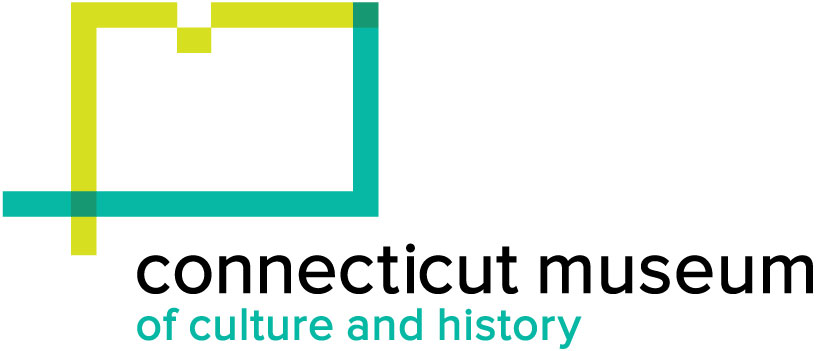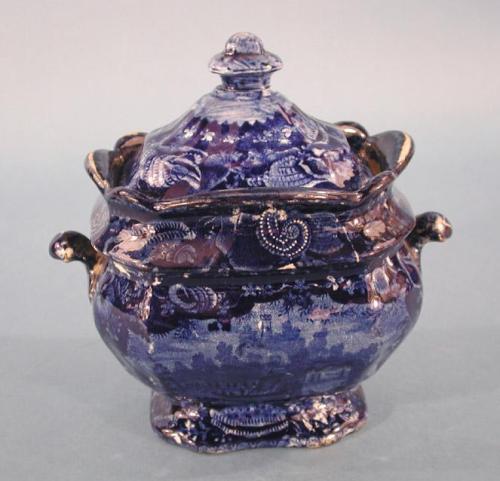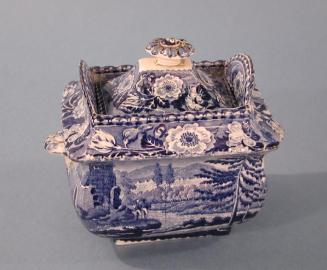Lidded Sugar Bowls
MakerPossibly made by
Enoch Wood & Sons
(English, July 1818-1846)
After a work byProbably after a wood engraving by
John Warner Barber
(American, 1798 - 1885)
Dateabout 1840
MediumMold-formed buff-colored earthenware with a blue-tinted glaze and underglaze cobalt blue decoration
DimensionsPrimary Dimensions (height including lid x width x depth of .2a,b): 7 1/2 x 7 1/2 x 3 7/8in. (19.1 x 19.1 x 9.8cm)
Primary Dimensions (height including lid x width x depth of .3a,b): 7 x 7 x 4 5/8in. (17.8 x 17.8 x 11.7cm)
ClassificationsCeramics
Credit LineGift of the heirs of Morgan B. Brainard
Object number1961.1.13.2a,b-.3a,b
DescriptionPair of rectangular sugar bowls (.2a and .3a) and lids (.2b and .3b) made of buff-colored earthenware with a blue-tinted glaze, a type of ceramic known as pearlware. Each sugar bowl has a rectangular foot with an undulating edge, and swelled sides that narrow and then swell again just below a standing rectangular rim. Each sugar bowl is decorated with a pattern that is transfer-printed on each side. The pattern shows three people in a sailboat with a single mast and sail on a body of water. Two more individuals are standing and one is sitting on the shore in the near foreground. Beyond the river, a building sits on a shore at the base of a mountain. A crenellated tower is at the top of the mountain. The patterns on each sugar bowl are surrounded on all sides by a border of white shells and light blue plants on a field of dark blue. There is a line of evenly spaced small white flowers at the inside and outside edges of each rim. Each sugar bowl has two molded and applied handles in the shape of scrolls. They are applied at either end over the each sugar bowl's two mold lines. The handles are decorated with portions of the border. Each sugar bowl also has a rectangular lid with a domed cover and a rectangular finial on top. Each lid is decorated with a border of white shells, small flowers, and leaves on a dark blue background.
Although the sugar bowls are quite similar, there are subtle differences between the two. The design on lidded sugar bowl .2a,b is very dark, resulting in a textured glaze. In contrast, the design on lidded sugar bowl .3a,b is crisp, and the glaze is smooth. The two patterns are also different. Each shows the same subject, but in .3a, the tower is taller and wider, and in .2a the mountain is lower. Please see the curatorial remarks for a more complete discussion of what these differences could mean.
Sugar bowl .2a has crazing and slight discoloration on all surfaces. Sugar bowl .3a has crazing and more significant discoloration on the inside. Sugar bowl .3a also has an area of imperfection in the glaze in the center of the pattern on one side.
NotesSubject Note: The pattern on these ceramics, titled "WADSWORTH TOWER", shows a tower built in 1810 by Daniel Wadsworth. The tower was built on top of Talcott Mountain, on Wadsworth's country estate, "Monte Video," in the town of Avon, Connecticut. Wadsworth's home on the estate, pictured in other Staffordshire ceramics, was near Wadsworth Tower, but is not pictured in this pattern. The tower commanded a fine view of the Connecticut river valley and was a popular resort for sight seers. It was blown down in 1840.Although the sugar bowls are quite similar, there are subtle differences between the two. The design on lidded sugar bowl .2a,b is very dark, resulting in a textured glaze. In contrast, the design on lidded sugar bowl .3a,b is crisp, and the glaze is smooth. The two patterns are also different. Each shows the same subject, but in .3a, the tower is taller and wider, and in .2a the mountain is lower. Please see the curatorial remarks for a more complete discussion of what these differences could mean.
Sugar bowl .2a has crazing and slight discoloration on all surfaces. Sugar bowl .3a has crazing and more significant discoloration on the inside. Sugar bowl .3a also has an area of imperfection in the glaze in the center of the pattern on one side.
Status
Not on view












